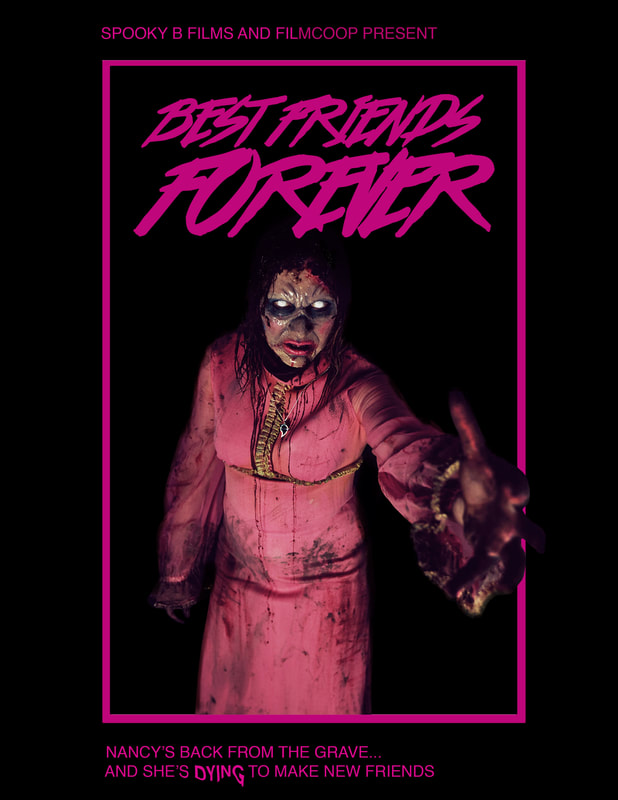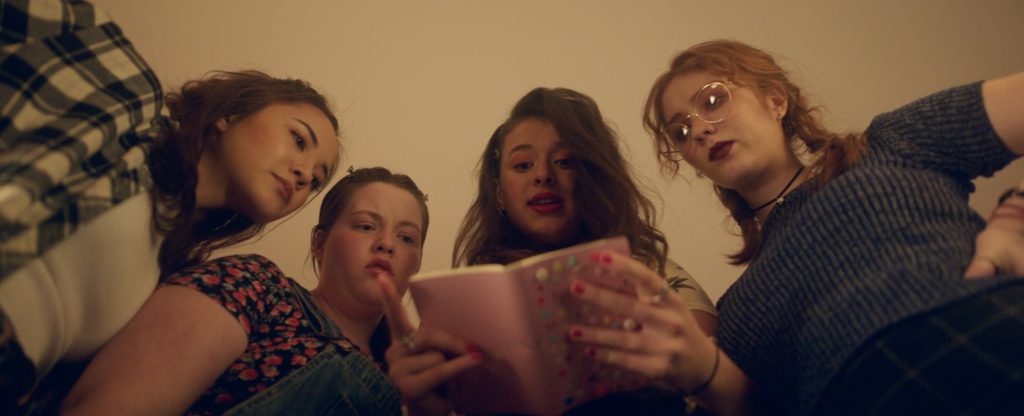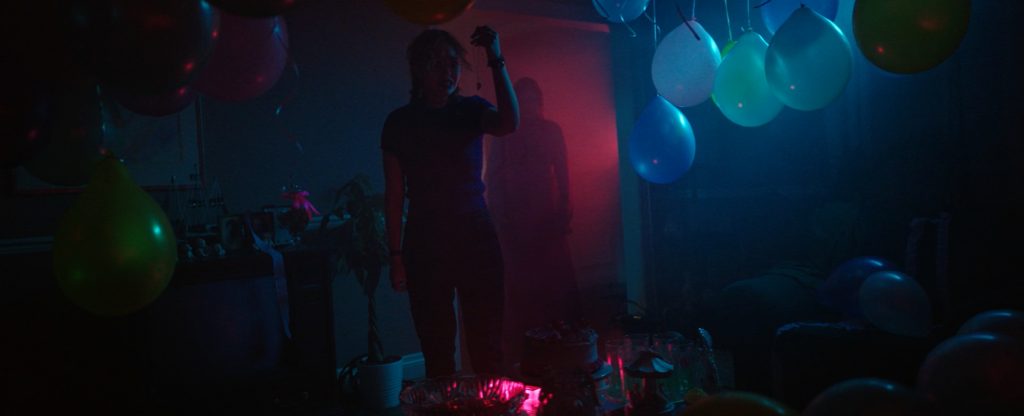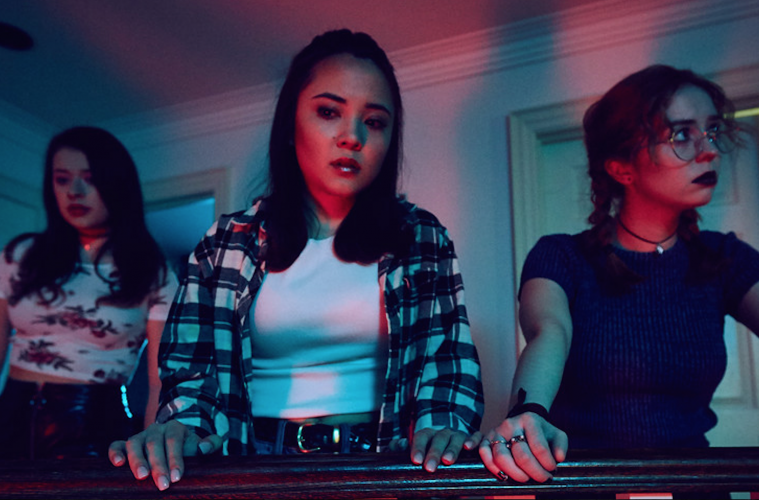Emily Gagne and Josh Korngut have been friends for two dozen years. Born and raised in Toronto, they’ve gone from being “little weirdos together” on the elementary school playground to co-writing and -directing Best Friends Forever (or BFF), a forthcoming horror short produced out of their own Spooky B Films.
Featuring a girls-only ensemble cast and made with a crew of mainly women and/or marginalized creators, the film tells a story about “the horrors of social exclusion.” Before it hits the festival circuit, I caught up with Emily and Josh about their history as a duo, their very different artistic influences, and why they wanted to make a film about the uglier side of female friendships.

Reel Honey: I obviously have to start by asking about your origin story as a pair. You met in the first grade and quickly bonded over your shared love of things like teen horror and the scarier kids’ shows that were big in the 90s, like Are You Afraid of the Dark. (For me, it was Tales from the Cryptkeeper.) Were you just instant friends and that’s that? You’ve been hanging around each other ever since?
Josh: I Know What You Did Last Summer was kind of our inauguration into big kid horror. After that, we began to exchange notes on the scary movies we’d convince our dads to let us rent over the weekends. We ran in different social circles in middle school, but we were always the weirdos and the weirdos have got to stick together. It’s helped keep us connected over the past 24 years.
Emily: I remember our first interaction so clearly. He was sitting across from me at a group desk and he just straight up asked me if I wanted to be his best friend. I said “no” because, you know, I was trying to be sensible. Over time, I guess you can say I grew to like him a bit. We were really little weirdos together, playing Sailor Moon at recess and obsessing about the creepy tree in the schoolyard dedicated to a student who had died years earlier. We are still weirdos together, but now we channel some of that energy into writing and Halloween party planning.
RH: These days, the two of you make up Spooky B Films, where your focus is on telling horror stories through a feminist lens. And I know that up until this point, you’ve each worked and still work in a number of different fields, from production to marketing to writing to social media. How long has filmmaking been something you’ve wanted to do individually, and how long have you known you might end up making a film together?
J: I made my first film when I was in the seventh grade. It was a parody of The Blair Witch Project and it was also my first ever film festival rejection. Later, I studied theatre at the University of Toronto and went on to write/create a few different plays around the city. One I’m still proud of was Unfriendly Stories (For Unpleasant People), an anthology of original campfire tales that ran in the upstairs space at Tarragon Theatre. A few years ago, I created another horror anthology titled Girl Up and Die, that time as a DIY webseries.
As for my creative partnership with Emily, well, that was always inevitable. We grew up together and our tastes in campy horror developed simultaneously. She understands the artistic value behind stuff that a lot of people are really quick to write off: Britney Spears, direct-to-video sequels, the early 2000s. That kind of thing. She’s got really good taste.
E: Honestly, when I was a young film fan, the idea of becoming a screenwriter or director seemed so unrealistic to me, probably because I didn’t see that many women’s names in the credits of most mainstream films. Josh is actually one of the people who encouraged me to write creatively as an adult, and, in effect, got me moving towards filmmaking, both with him and on my own. He has always believed in me as a creator, has always seen something in me that I couldn’t see. I’m so grateful he showed me the way because I’ve truly never been happier than I am when I’m writing or brainstorming a new creative idea.
I wrote some creative stuff as a kid, including a now-infamous (in my family, anyway) short story called The Night of the Big Crash, but I didn’t really think about writing professionally until I was a teenager. I ended up getting a Bachelor of Journalism from Ryerson [University] and I worked as a TV critic for a few years after that, which was really fun and helped me get some insight into the creative process and what sets are like. More recently, I’ve moved into social media work to pay the bills because, well, full-time journalism jobs are few and far between. Filmmaking and other creative work—I also have a podcast and screening series focused on women in film—is what drives me more emotionally.
RH: Do you differ at all in your favourite horror films, or films generally speaking? Or do you both share a lot of the same influences?
J: It’s kind of complicated. We have similar tastes, but we’re also very, very different. I’m really into indie horror and Emily is more into thrillers and 80s cult, I think. I’m a big fan of Vincenzo Natali’s Cube and the French vampire ballet-school flick Livide. There’s this direct-to-video horror movie from 2003 titled Dead End that I’m particularly obsessed with. If you haven’t seen it, please go find it. It stars Lin Shaye and it’s about a family who gets lost taking a shortcut while driving out to a dinner party. I also love a classic urban legend—Candyman, Black Christmas, The Ring, etc.
E: I think my taste is a lot more “lowbrow” than Josh’s? As he mentioned, I really love cheesy, over-the-top horror films and thrillers like, say, Hello Mary Lou: Prom Night II or The Hand That Rocks the Cradle. I also crave a good dark comedy with women at the centre—think Don’t Tell Mom the Babysitter’s Dead, Drop Dead Gorgeous.
I think one of the things that has united Josh and I is our love of female protagonists, particularly in the horror space. I just love seeing girls and women at the centre of terror, whether they are the heroes, villains, or both. In some ways, I think horror is actually the most empowering genre for women because, well, they exist in it.

RH: You’ve described BFF as being about “the horrors of social exclusion” and the sometimes toxic relationships between younger girls. I realize I’m prying but I’d love to know why that’s the focus here.
E: I definitely experienced girl-on-girl hate when I was young. I’m not saying that I didn’t participate in it, too, as many people do under peer pressure, but I was definitely on the receiving end of it a lot, especially in my tween years. I think a lot of this kind of behaviour stems from the fact that we’ve been told since we were kids, whether directly or indirectly, that there are only so many spots for women at “the top,” whatever that means. We have been brainwashed to overanalyze our behaviours, our appearances, and, in effect, other women’s.
As much as I think it’s important to celebrate positive relationships between women—which are truly wonderful, necessary, and honestly the backbone of society, I also think it’s a mistake not to portray the uglier side. We need to see the effect that hatred can have. One of my favourite movies is Carrie and I think it’s because it owns up to the monstrosity that is girls bullying other girls. It was a huge influence for me in creating BFF.
J: As a gay man with predominately female friends, I sometimes get to feel like a fly on the wall when it comes to girl-on-girl relationships. It’s a unique POV, but it’s also a dynamic that I don’t have full access to. I was raised by my mother and her three sisters, and I’ve seen those relationships really struggle as I’ve grown older. Those women have always inspired my work. Baggage can seem so inescapable sometimes.
RH: I know that it’s also set in the 90s, and I’m curious if there was a particular reason behind that choice, or if it’s just a decade that has significance for you both based on your friendship history and your inspirations for the film.
J: Setting this story in the 90s was always a given. We both grew up in North York during the 90s and the nostalgia of that place/time is such a big part of our shared unconscious. We were inspired by that feeling of going to the grocery store as a kid and clocking the Halloween decorations for the first time that season. Or exploring the vast and desolate park nearby until you discover something that maybe you shouldn’t have.
Besides the nostalgia factor, there’s also something genuinely frightening about the 90s in the suburbs. You’re alone, but you’re not. You’ve got neighbours, but they’re not going to help. I think back to that scene in Halloween where Laurie is screaming out while running down the street, away from Michael. Nobody comes to her aid. She’s on her own. Haddonfield can look a lot like North York if you squint just right.
E: It’s funny. We actually ended up shooting the film at my parents’ house in North York, where I lived from ages 10 to 24. It was a full circle moment for sure.
RH: Your crew is also mostly made up of women and/or marginalized creators. How intentional was that on your end, and what was being on set like?
E: We always wanted BFF to be a very inclusive project. We set out to write a horror story about young women where no men were seen or mentioned, and we achieved that. It only made sense to have our set populated with as many women as possible as well.
On a more political level, I think it’s really important to use your power to empower others. From casting to crewing up, we were very conscious about seeking out a diverse pool of creators for all our key roles. In the end, we wound up finding a dynamic team that really was able to bring our very specific vision to life in a thoughtful way.
J: It was definitely a conscious decision. We had an experience on a previous project where male creators would communicate with me, but not with Emily or my other creative partner, Samantha. It was really eye-opening and we didn’t want to go through that again.

RH: I don’t want to keep rehashing Jason Blum’s comment from last October about there being very few female directors, especially since he apologized for it and it’s such a strangely ubiquitous myth, but I did want to ask about the second part of his comment, which arguably got less traction online, and that was that there are “even [fewer women] who are inclined to do horror.” What is your take on that?
E: I am living proof that women want to do horror. And I know a ton of other women who are trying to break into the genre after years of loving it as a fan. The question is, are you asking them, or are you just asking the same pool of filmmakers over and over again?
J: It’s frustrating, it would be so easy for them to make the change. I don’t understand what they’re waiting for, we’re seeing female filmmakers deliver huge box-office numbers. It just seems like bad business to me.
RH: Who are the filmmakers and creators working today whom you really admire, especially in the horror sphere?
J: I’m really inspired by the work of Petra Collins right now. When Emily and I started working on BFF, we built a Pinterest board to get the creative ball rolling. A surprising number of images we ended up pinning were from different Petra Collins fashion campaigns. I love her editorial work, not to mention the music videos she’s directed for Selena Gomez, Carly Rae Jepsen, Cardi B, and others. She also happens to be from Toronto.
To pivot a bit, though, the first thing I do when I want to get creative is turn to music. I’m really inspired by a lot of female musicians. Tori Amos is my longtime favourite, but I also really love Kate Bush, Joanna Newsom, Bat for Lashes, Lana Del Rey, Rasputina, Hole, and so many others.
E: One of my biggest influences, by far, is Diablo Cody. I saw Juno at TIFF back in 2007 and was blown away. This was her first script ever and she ended up winning an Oscar for it! That was really the first time I saw, or at least noticed, a woman recognized for screenwriting in Hollywood. It was a turning point for me in terms of realizing maybe I could and should start creating again.
But going back to the genre, I have loved pretty much all of her other scripts, including Jennifer’s Body, which I think a lot of people agree was really misunderstood upon its release and is really a modern feminist masterpiece. That movie, which was directed by another badass who often works in genre [Karen Kusama], is proof that stories about women can be gross, fun and heartbreaking all at the same time. Also, it’s named after a Hole song, which is just cool as hell.
RH: What’s next for BFF and where can people keep up with any news about it?
E: We’ve applied to a bunch of festivals for summer and fall and are waiting to hear back. We’ll see what happens, but I’m really proud of what we’ve accomplished and I think it will really resonate with the genre crowd, especially with the current wave of nostalgia for 90s horror kids content.
J: You can keep updated on our website and social feeds. We’re on Facebook, Instagram, Twitter and even Pinterest. We’re really getting this baby out there.

